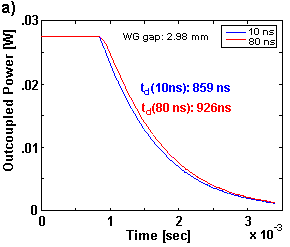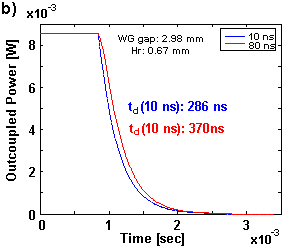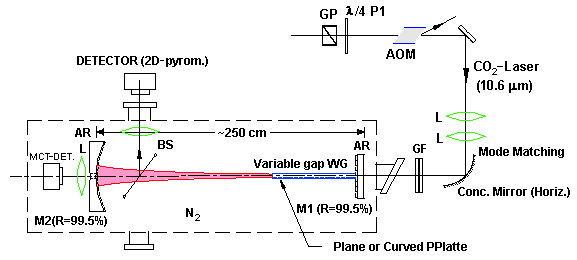|
A symmetric waveguide resonator configuration incorporating toroidal mirrors
and a waveguide structure extending along the undulator section has been
proposed for the 30 mm-150 mm far infrared FEL [1].
The use of toroidal resonator mirrors with optimized radius of curvatures helps
to reduce cavity losses arising from the transition of the free space propagating
mode into a wave guided one. The experimental study of the loss mechanism will
be accomplished by means of a test resonator that is scaled down to the dimensions
of an optical bench, according to the wavelength (10.6 mm) of the employed
cw CO2 seed-Laser. Measurements of the cavity ring down (CRD) time
will determine the Q-Factor of the cavity and the associated resonator losses.
To be able to apply the CRD method, it is important to have the switching-off
time of the pump laser being considerably shorter than the intracavity power
decaying due to the loss mechanism (Fig. 1).

|

|
|
Fig. 1 Simulated dependence of the outcoupled-pow
er decay
time on the pump-laser switching-off duration. In Fig. b), additional losses
due to a 1.35 mm diameter outcoupling hole has been taken into account leading
to a shorter decay time.
|
In the planned experiments,
after reaching steady-state, the power in the optical cavity will be switched-off
within 80 ns using a acusto-optical modulator (AOM). The time dependence of
the light intensity inside the cavity is then monitored by detection of the
outcoupled light through the resonator mirror (Fig. 2) using a liquid-nitrogen
cooled HgCdTe detector (MCT). A lens configuration located in front of the
coupling mirror provides the necessary matching of the injected laser-mode
profile into the lowest order hybrid mode excited in a parallel-plate waveguide.
In order to obtain an estimate for the losses and the associated cavity power
decay time, a code has been developed based on the scalar diffraction theory [2].
It models the loss mechanism accounting for effects such as field
outcoupling through the hole, mode conversion due to the hole and waveguide
aperture,
clipping-off the optical field at waveguide ends, transverse mode-matching
of the injected laser-mode into hybrid modes, cross-coupling among the excited
modes as well as temporal profile of the pump-laser decaying .

Fig. 2
Schematic of the cavity ring down measurement setup.
1 Tel Aviv University, Physical Electronics
References
[1] M. Tecimer and R. Wünsch,
this Report
[2] A. E. Siegman, Lasers, University
Science Books, Sausalita CA, 1986
IKH
05/22/01
© M. Tecimer
|


